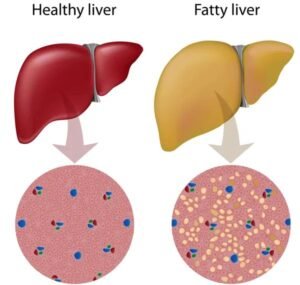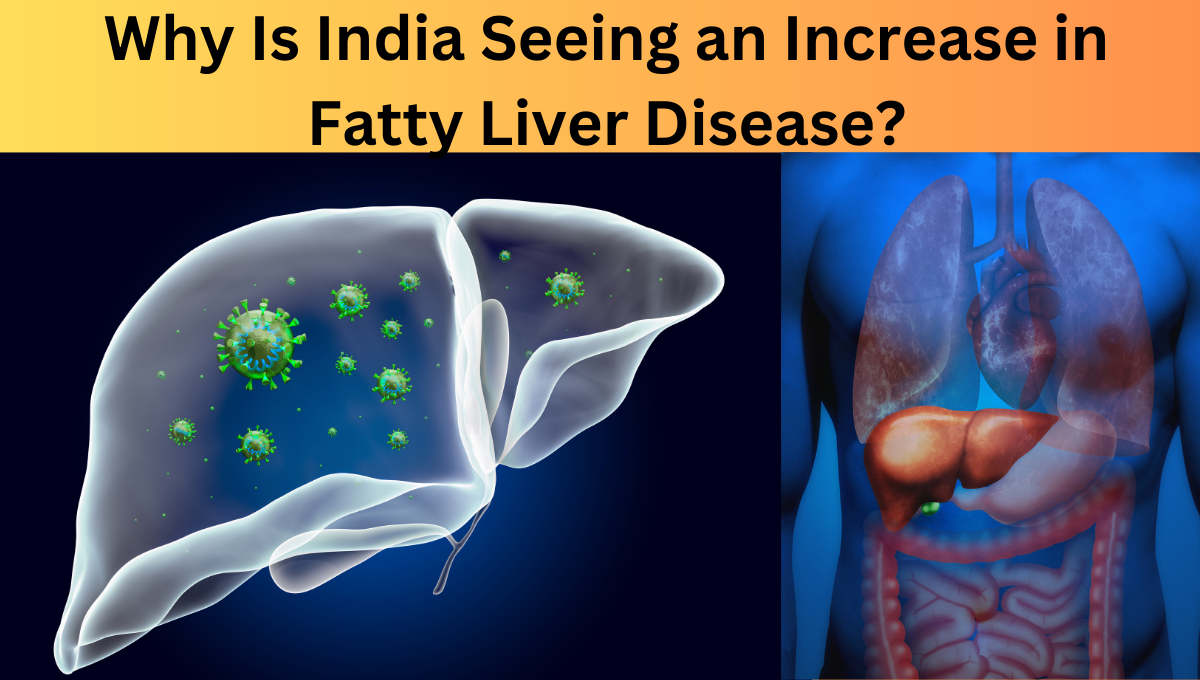Why Is India Seeing an Increase in Fatty Liver Disease?
Non-alcoholic fatty liver disease (NAFLD), the medical term for fatty liver disease, is a growing health concern in India. Once believed to be exclusive to the West, the ailment is becoming a major worry in India as a result of dietary changes, lifestyle changes, and other contributing factors. The underlying causes of the startling increase in fatty liver disease in India, its effects on public health, and methods to combat this expanding epidemic are all examined in this article.

Comprehending Fatty Liver Disease
When the amount of fat in the liver cells exceeds 5% to 10% of the liver’s weight, fatty liver disease develops. It is divided into two primary categories:
Alcoholic Fatty Liver Disease (AFLD): A condition brought on by consuming too much alcohol.
Regardless of alcohol consumption, non-alcoholic fatty liver disease (NAFLD) is linked to metabolic and lifestyle issues.
A major risk to general health, non-alcoholic steatohepatitis (NASH), liver fibrosis, cirrhosis, and even liver cancer can develop from NAFLD.
India’s Increasing Fatty Liver Disease Prevalence
1. Urbanization and Changes in Lifestyle
In recent decades, India has experienced fast economic expansion and urbanization, which has had a big impact on people’s lifestyle choices. The increase in incidence of fatty liver is caused by the following factors:


Sedentary Behavior: Because of office-based professions, people spend more time on screens and engage in less physical activity.
Unhealthy Diets: A move toward processed foods and beverages with added sugar, as well as other high-calorie, low-nutrient foods.
Sleep Disturbances: Long workdays and urban stress lead to irregular sleep patterns, which worsen metabolic diseases.
2. Growing Obesity Epidemic One of the main risk factors for NAFLD is obesity. In India:

Rates of Adult Obesity: Overweight and obese people currently make up a sizable segment of the population.
Obesity in Children: The early emergence of NAFLD is associated with alarming rates of childhood obesity, which may result in long-term health issues.
3. Metabolic syndrome and diabetes
With millions of people living with Type 2 diabetes and insulin resistance, India is frequently referred to as the diabetes capital of the world. Fatty liver disease development is intimately linked to these disorders. Furthermore:
The growth of NAFLD has been further driven by the increasing frequency of metabolic syndrome, which includes high lipid levels, obesity, and hypertension.
4. Hereditary Propensity
Studies have shown that South Asians, particularly Indians, are genetically predisposed to liver fat accumulation and insulin resistance. Higher risks of NAFLD in this population are associated with genetic variations of PNPLA3 and TM6SF2.
The Effects of Fatty Liver Disease on Society
In addition to affecting a person’s health, fatty liver disease has wider societal repercussions.
Healthcare Costs: Families and healthcare systems bear a heavy cost burden while managing advanced liver disease, which includes cirrhosis and liver transplants.
Productivity Loss: Absenteeism due to liver disease, mental health issues, and exhaustion all have an impact on job productivity.
Quality of Life: Both physical and mental health are greatly impacted by the disease’s course.
Important Risk Elements Fueling the Epidemic
1. A diet heavy in carbohydrates and low in protein

Traditional Indian diets tend to be low in protein and rich in carbs (rice, wheat), especially in rural areas. This disparity may result in:
excessive hepatic fat accumulation.
elevated insulin resistance hazards.
2. Drinking Alcohol

Even while alcohol does not cause NAFLD, increasing urban alcohol use causes compounded liver damage in people who are already at risk for fatty liver.
3. Ignorance
Many persons with fatty liver disease go untreated until the condition has advanced to a severe degree due to a lack of knowledge about the condition.
Untreated Fatty Liver Disease Complications
Fatty liver disease can have serious problems like the following if it is not treated:
Liver tissue scarring that affects liver function is known as liver fibrosis or cirrhosis.
Cardiovascular Disease: Associated metabolic problems raise the risk of heart attack and stroke.
One kind of liver cancer that can progress to advanced stages is hepatocellular carcinoma.
Strategies for Avoiding and Treating Fatty Liver Disease
1. Changing to a Healthier Diet
A Mediterranean-style diet should be prioritized, which consists of a lot of fruits and vegetables, lean proteins, whole grains, and good fats like omega-3s.
Limit your consumption of trans fats, processed carbohydrates, and sugary meals.
2. Increasing Exercise

Get in at least 150 minutes a week of moderate-intensity activity, including swimming, cycling, or brisk walking.
Strength training has been shown to promote liver health and reduce visceral fat.
3. Controlling Weight
Reducing hepatic fat formation requires maintaining a healthy weight. Aim for:
Gradual weight loss: Liver health can be greatly enhanced by losing 5% to 10% of body weight.
4. Consistent Screening
Early detection is essential. Regular screening is recommended for anyone with risk factors like obesity, diabetes, or a family history of liver disease. These screenings should include:
To find fatty infiltration, use ultrasound.
Liver function tests, or LFTs, are used to track the levels of liver enzymes.
5. Steer clear of unnecessary supplements and medications.
The liver might be harmed by some drugs and herbal medicines. Before beginning any new treatment, speak with your healthcare specialists.
Initiatives from the Government and the Community
1. Campaigns for Public Health
Like its anti-tobacco and anti-diabetes programs, the Indian government should give liver health awareness campaigns top priority.
2. Inexpensive Screening Initiatives
Early detection can be facilitated by establishing community-based liver health screening programs in both urban and rural settings.
3. Investigation and Information Gathering
Putting money into studies on fatty liver disease in Indians will aid in the creation of specialized therapies and therapeutic approaches.
In conclusion
Fatty liver disease is becoming more common in India, which is a reflection of the country’s evolving health and lifestyle. A multimodal strategy that incorporates early screening, lifestyle changes, and raised public awareness is needed to combat this epidemic. Fighting this expanding health epidemic requires cooperation from citizens, medical professionals, and legislators.


5 thoughts on “Why Is India Seeing an Increase in Fatty Liver Disease?”